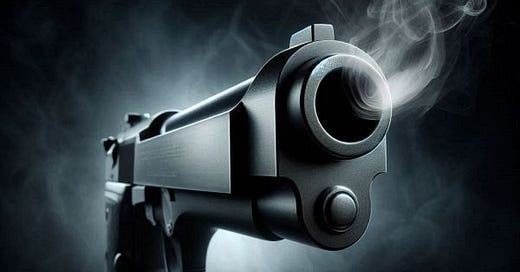The test results showing that insulin had been given to them was the only piece of concrete evidence of criminality throughout the whole of the prosecution’s case. It was the closest thing they had to a smoking gun and became the keystone for their case as a whole.
Johnson’s argument ran that if the jury could agree that Letby had deliberately poisoned two babies, they could also reasonably conclude that she had harmed others using different methods, even if the evidence for those were less concrete. In the event, the insulin cases were the first on which the jury reached a verdict.
—The actual evidence against Lucy Letby, The Times, February 5, 2025
One flash of light
But no smoking pistol.—David Bowie, Ashes to Ashes (1979)
Of all the strands of Lucy Letby’s trial, the insulin evidence is the most difficult — in that it is hard for non-specialists to fathom — but also pivotal, as it is the only “smoking gun” in the whole case. Unlike any other piece of evidence, it seems unequivocally to suggest actual malice.
But that is to beg a large question, so let’s back up a bit.
Now I am no kind of expert about anything much, and certainly not glycaemia. Talk of picomoles, immunoassays and C-peptides alternately bores and intimidates me. So we can leave all that to the experts — perhaps with the marginal note that it is so difficult even they don’t seem to be able to agree about it — and talk instead about the test results, in the round, as evidence.
Start at the very beginning —
As with many of the allegations in this trial, the Cheshire police appear to have started investigating at the end — nearly the end, at any rate: there was a later twist — and then worked backwards. I can’t help wondering how different the outcome might have been had they only started at the beginning.
Their original focus was this:
Scientific tests suggest two children, Baby F and Baby L, were administered “factitious” insulin.1
Since they were not prescribed it, and no one owned up to accidentally administering it, this points, presumptively, to malice.
Even without understanding how immunoassays work, we can see this is still not open and shut: it is circumstantial: it requires an inference that dirty work is afoot.
Without better evidence, it weighs on the prosecution’s side.
But there may be better evidence. It may undermine that inference.
For one thing, the test may not have been reliable: perhaps the apparatus was mis-calibrated.2 Maybe the sample was contaminated. Perhaps the result was a false positive. Maybe the examiner misread it.
But even before doing that, we should first look with an open mind for positively innocent explanations. For, all other things being equal, deliberate insulin poisoning on a neonatal ward is not common. Over the history of healthcare, it has not happened very often.
If the odds are there is a more likely explanation, the least we should do is look for it.
But it doesn’t seem the Cheshire police did this with any great gusto. Rather, armed with their burgeoning theory of an angel of death on the ward — probably with a particular “death angel” in mind — the police saw a smoking gun. They spent little time looking for innocent explanations. They spent little time corroborating this one.
They had their suspect.
This might come to be seen as an oversight. For if there has been an insulin poisoning, we would expect other evidence to corroborate it. We might ask who accessed insulin. We might ask whether any insulin was missing. We might look for tell-tale signs of tampering with drip bags.3 And we might want some evidence that Ms. Letby had had something to do with it.
Remember the burden of proof: the Crown must show beyond reasonable doubt that this was factitious insulin, and that it was maliciously administered, and that Lucy Letby administered it. The Crown had a prima facie case for this first limb, but nothing to support the second or the third.
Unasked questions
Only very small volumes of insulin needed to be added to the half litre bags of feed; it was not noticeable in the bag, nor would it be apparent that any was missing from the insulin bottle.
—Sentencing Remarks, Mr Justice Goss, August 21, 2023
Now: absence of evidence is not evidence of absence, sure. But when we find absence after absence of evidence where, on a random roll of the dice, once in a while you would expect to find some — if, on every roll, the evidential dice keep coming up snake-eye — we should be asking questions.
No matter how brilliant a criminal mastermind, a killer would have to get some insulin from somewhere and insert it in the feed bags somehow. All other things being equal, you would expect evidence for these necessary steps to accumulate. The more consecutive absences there are, the more this begins to feel like improbability.
And even if we find none — a successful villain covers her tracks, after all — we should at least expect evidence to point away from other innocent explanations. So, let us see:
Was there evidence of Ms. Letby taking or requesting any insulin?
No.
There are no documents, witnesses, or physical evidence (even consistent with Ms. Letby accessing insulin. The prosecution implies she could have taken it opportunistically from the unit’s supply — and logically, this is true, but the fact remains: there is no evidence that she did. Absence of evidence is not evidence of anything.
Is there evidence any insulin went missing?
No.
Stock checks weren’t detailed enough to confirm missing insulin, but it is still true that no discrepancies were recorded. The Crown might say the amounts involved were small enough to go unnoticed — and logically, this is true, but the fact remains: no tangible loss was recorded. Absence of evidence is not evidence of anything.
Is there evidence of Lucy Letby tampering with any feeding bags?
There were no eye-witnesses, and no forensic evidence on any of the bags linking her to any tampering with it. No fingerprints, no puncture wounds, no traces of insulin found where they should not have been. Modern feed bags have sterile ports through which one can introduce medicines, so there was no need to puncture the bags, and the Crown might say the bags were thrown out before they could be checked — and logically, this is true, but the fact remains: no-one saw any reason to check them. Absence of evidence is not evidence of anything.
Is there evidence any feeding bags were tampered with at all?
The bags were discarded as part of routine practice without being checked. The prosecution’s theory assumes they were tampered with — and logically, it is true, they could have been, but the fact remains: there is no evidence that they were. Absence of evidence is not evidence of anything.4
Is there evidence Ms. Letby researched insulin, or insulin poisoning, on the internet?
And the police looked. They searched her devices and home. They dug up her garden. Ms. Letby might have been a zen master of surreptition in every other dimension of her criminal enterprise, but she was incautious about her internet search histories. Yet the police found no searches about insulin — nor for that matter, air embolus, overfeeding by milk or liver damage by Vulcan mind-meld. The prosecution might argue that, being a diligent nurse, she already know this anyway, but still. Absence of evidence is not evidence of anything.
Not only was no such evidence uncovered, as far as we know, no one really even looked for it. The police had their smoking gun, their expert witness was on his way from wales, so poor old “Nurse Death” was for the high-jump.
This consistent absence of evidence in scenarios where, on another day, evidence might exist, start to resemble a different kind of smoking gun.
And that is before we consider the twist.
That twist
Imentioned at the top that the police started their investigation near where it should have ended. This where they found their smoking gun: the insulin tests results raised a strong presumption of foul play.
Though not an endocrinologist, lead prosecution expert Dr. Evans thought it was indisputable.
Others would later disagree with his assessment — after the trial — but one thing all experts have consistently agreed on is that the readings, irrespective of their reliability, were extremely high. This is how the Cheshire police could be so confident of bringing charges in the first place.
Now, back to our theme of “unasked questions”. How reliable were these tests? Dr. Evans has often spoken about the unequivocal implications of these results, but rarely about their likely accuracy. But if they were accurate there is an unfakeable, unhideable piece of corroborating evidence you would expect to see. You would expect the victims to fall into a coma and then die. Not certainly, if diagnosed and treated instantly, but very probably.
So here is the twist, which happened just after the point at which the police drew all their conclusions:
Both infants survived.5
Now — we are in the world of probabilities. Survival is possible, but it was not the most probable outcome if the test results were correct.
So, here is another “missing” corroboration: the most probable clinical outcome of the test results, if they were accurate, didn’t happen.
So, if this was a murder attempt by massive insulin overdose — and that’s unusual enough in itself, remember— and if the doses really were as big as the test results suggest they were, then the fact that the attempts failed is even stranger.
This really is the most unlikely case.
An alternative explanation, apparently not considered at the time, was this: the test results were wrong.6 This was an “ordinary” neonatal hypoglycaemic episode. No malice was involved.
Now: there is a counter-argument the prosecution might put here. It goes like this:
The NICU specialists at the Countess of Chester Hospital were a crack squad of experts and only their swift intervention defeated Ms. Letby’s grim machinations and saved the day.
Okay: let’s go with that, though — honestly? — it is something you’d expect a master manipulator and criminal genius to have thought about beforehand. It significantly reduces her chance of success and greatly increases her risk of detection.
In other words, isn’t the slow-release of a massive dose of insulin under the watchful eyes of a crack squad of neonatal experts in an ICU which is monitored up to the hilt, a spectacularly bad way of surreptitiously committing murder? And isn’t it all a bit Batman villain?
Selection bias?
Now there is another implication of the children’s initial recoveries. It calls into question how, and why, the prosecution selected the events with which Ms. Letby was charged in the first place. Particularly these ones.
An episode of hypoglycaemia followed by a recovery is not an inherently suspicious event in a neonatal unit. In fact, premature infants are somewhat prone to it.7 So much so that you would not expect such an episode to be reported on datix, or registered as a “near miss”, or anything like that. It might be recorded, but it would merge into the background noise of hospital data flying around: over 15 months, and 1,300 shifts, you would not expect “hypoglycaemic episode with recovery” to stand out. Especially not if your frame of reference was “unexpected infant mortalities”.
And so it seems: when the test results came back they were logged, but no-one acted on them. They were filed. They did not show up as evidence of “foul play” until the police investigation in late 2017. By this point, Ms. Letby was already in the crosshairs.8
So what happened? Did prosecutors stumble randomly on these records, unremarkable though they were, pull them up, get somehow hinky about them, and only then realise that, by crikey, Ms. Letby was on duty when these episodes occurred?
Or did it happen the other way around? Did they isolate all Ms. Letby’s shifts and drill into them, looking for anything they could find?
This might seem a small point, but in the context of the “dodgy shift rota” — the only piece of identification evidence positively implicating Ms. Letby — it is massive.9
“Man with a hammer” bias
We are pattern-matching machines. When we are artificially motivated to find certain patterns and discouraged by system incentives from looking for other ones, we get good at zeroing in on what we are hoping to find. If you had to design laboratory conditions that were optimised for prosecutor’s tunnel vision, you could scarcely do better than what we have here.
This is a form of remunerated confirmation bias. Experts, particularly, are primed and motivated to see patterns that conform to existing structures in their professional calling — call this “expert validation bias” or “man with a hammer” bias. Experts are no different from the rest of us: we all construct our world using tools already in our shed.
Experts are also motivated to embrace narratives that promote their own professional significance (you might call this “make way, I’m a doctor” bias, though it is really just an aspect of expert validation bias).
Police officers exist to find crimes.
Prosecutors exist to deliver convictions.
Expert witnesses see what their clients want them to see. The Crown Prosecution Service is not in the habit of engaging expert witnesses to blow up its prosecutions.10
Disconfirmation bias
One way of disarming this systemic confirmation bias would be to incentivise, or somehow compel, the Crown to actively seek out gaps in its own case: missing corroborations that one would expect to find were the prosecution theory true. To introduce some disconfirmation bias, in other words. Actually, it is supposed to do this already, but it is a rule honoured in the breach.11
If your theory is that a dead-eye marksman has been potshotting a single point on your Texan barn, a thorough review of the rest of the barn, surrounding trees, fenceposts and nearby outhouses for bullet holes will give a better picture of your barn: that is, one without a target painted on it.
This is not how an adversarial system naturally behaves: it expects each side to aggressively promote its own interest. Plainly, the prosecution cannot be expected to lean doggedly into the pursuit of exculpatory evidence even if it is meant to, but the defence certainly can.
But this somewhat undermines the sacred precept of criminal liability: the burden of proof is on the prosecution. It should not be — is not — the defence’s job to prove anything. After all, how is an innocent defendant supposed to know how an alleged crime went down?
Furthermore, in certain cases, and Ms. Letby’s is one, the vital exculpatory evidence may lie within the prosecutor’s confidential possession. For example, what was the prosecution’s methodology for selecting suspicious events?12 The CPS has declined to say, but seeing that the consultants named Ms. Letby when they first met with police, it would not be a surprise to discover that, in Mr Myers’ ungainly phrase:
[Ms. Letby’s presence] has, in effect, become a search term and a parameter for bringing a prosecution.
On not asking questions you won’t like the answer to
Prosecutors may be supposed to open-mindedly challenge their own theory of the case, but the rules of court procedure positively disincentivise them from actually doing it. Should they look for disconfirming evidence, and find it, they must at once turn it over to the defence.13 This hardly encourages them to chase down potentially exonerating lines of enquiry. If you ask a silly question, you will get a silly answer. So do not ask silly questions, being ones you do not want to know the answer to.14
Theoretically, there are safeguards against this behaviour: prosecutors have an abstract duty to seek exculpatory evidence, and there is judicial oversight of the disclosure process, but these are hard to enforce, and, and judging by recent experience — the Post Office Horizon debacle refers — don’t work very well. They are especially ineffective early in an investigation before charges have been laid. Who then is watching over the police’s shoulder making sure they ask themselves hard questions?
Nor do they really address the fundamental problem of “not asking questions you don’t want to know the answers to”.
Were prosecutors required to file with the court not just a charge sheet but a table of alternative theories they’d considered and the steps they’d taken to test these theories, and their rationale for dismissing these alternative explanations, this would create direct judicial oversight of investigative thoroughness and would give defence a stick with which to beat lazy prosecution teams. This may create additional costs and place additional burdens on police and prosecution teams, but if applied at a significant threshold, this would seem a justified burden in light of the potential consequences of criminal conviction. Ms. Letby is, after all, serving fifteen whole-life sentences for something it seems quite likely she didn’t do.
See also
Also described as “exogenous”, this means the intentional use of insulin to induce hypoglycemia, as opposed to insulin generated naturally in the pancreas.
I still have imprinted on my brain from my criminal law lectures in 1989 the brand of the breathalyser test, the Draeger Normalair Alcotest® 80, that was routinely miscalibrated in drink-driving cases in New Zealand 50 years ago.
In Victorino Chua’s case, saline bags had been stabbed with a needle and were leaking.
The reason no one thought to keep the bags is also germane: while staff treated the hypoglycaemia as a medical emergency, they did not suspect insulin poisoning. Hypoglycaemia in premature infants is relatively common and has many non-malicious causes, so no-one suspected foul play.
At the time of the tests, both children apparently recovered, and the episodes were treated by hospital staff as such. Mr. Justice Goss mentioned in sentencing that one of the infants transpired to have severe learning difficulties. These may have been caused by the episode of hypoglaemia (though neither effect nor causation were addressed at trial), but what is relevant to the “crime selection” issue is the apparent significance of the event at the time the charges were formulated.
The test results were never tested despite a warning, printed in red, on the information sheet accompanying the test kit that immunoassays are not suitable for forensic use on account of their unreliability.
Hypoglycemia in the preterm neonate: etiopathogenesis, diagnosis, management and long-term outcomes, National Library of Medicine (US).
Per Chief Superintendent Nigel Wenham’s file note of his first meeting with the CoCH consultants on 15 May 2017, Stephen Brearey raised the concern that a nurse was present in all but one of the deaths, and names Ms. Letby that nurse. Mr. Jayaram is recorded as saying “we are not on a witch hunt, we have concerns that this nurse was present in far too many occasion” (sic). Note this is before Dr. Evans’ involvement (he wrote to offer his services to Cheshire Police in May 2017, and was only engaged months later).
In this case, lead prosecution expert witness Dr. Dewi Evans didn’t wait for the police to call, but volunteered his services.
Per the Code for Crown Prosecutors, “Prosecutors must consider at this stage and throughout the case whether there is any material that may affect the assessment of the sufficiency of evidence, including examined and unexamined material in the possession of the police, and material that may be obtained through further reasonable lines of inquiry.”
You would think, wouldn’t you, that this question is obviously of great relevance and ought to have been disclosed to the defence. It was not. The defence applied to the court for an order compelling disclosure under Section 7A of the Criminal Procedure and Investigations Act. The prosecution opposed this application, and Mr. Justice Goss rejected it.
See Section 7A(2)(a) of the Criminal Procedure and Investigations Act 1996. Discussed also at “Lucy Letby: how the charges were selected”.
It seems the Crown Prosecution Service actively shut down police inquiries into statistical analytics. Citing privilege, CPS actively rejected FOI applications for more information about this decision. The information commissioner accepted the CPS position: Freedom of Information Act 2000 decision notice dated March, 12 2025.












Share this post